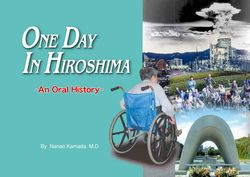You are welcome to download and freely use any of the resources on this page for peace-related and educational purposes.
Witness Trees of Hiroshima: Spherical Photodocumentary of the Hibaku Jomoku
In August 2014, Outreach Ecology visited Hiroshima and together with Green Legacy Hiroshima, visited the sites of Hiroshima’s a-bomb-survivor-trees. Outreach Ecology took a series of spherical panorama photographs using Google Photo Sphere.
In this report, Outreach Ecology present the digital photospheres and offer some suggestions for using the resources in projects relating to the a-bomb-survivor-trees.
Outreach Ecology is a small business providing services that help spread wonder for the natural world, passion for understanding nature , and inspiration for living.
Spreading Hiroshima’s Spirit of Peace
by Tomoko Watanabe
Tomoko Watanabe, Founder and Executive Director of ANT-Hiroshima, talks about growing up in Hiroshima in the aftermath of World War Two and the atom-bombing of the city.
Contents: The A-bomb Experience; Destruction and Rebirth; A Fortress of Peace; ANT-Hiroshima’s Work; International Peace Activities; International Cooperation Activities; Educational Activities; Resources.
 Hiroshimas Friedensbotschaft Verbreiten
Hiroshimas Friedensbotschaft Verbreiten
von Tomoko Watanabe, Geschäftsführer von ANT-Hiroshima
Inhalt: Die Erfahrung der Atombombe; Zerstörung und Wiedergeburt; Eine Friedens-Festung; ANT-Hiroshima; Aktivitäten in internationaler Zusammenarbeit; Bildungsaktivitäten; Die Botschaft von Koji Hosokawa, einem Überlebenden der Atombombe
by Nanao Kamada, M.D., M.Sc.
Contents: An Oral History in three parts: “Past,” “Present” and “Future” with many photos, charts and technical explanations to support the main narrative, which is in the form of an interview with an elderly woman who survived the bombing in Hiroshima. Various questions about her life after the attack are asked and answered. The aim is to convey the actual situation of the a-bomb survivors.
Audio Recording of Sadako’s Prayer
Written and illustrated by Fauzia Aziz Minallah, narrated by Marie Tsuruda.
Sadako’s Prayer tells the story of Sadako Sasaki, a school girl who survived the atomic bombing of Hiroshima on August 6th 1945, but contracted leukemia as an effect of the bombing. We hear how she began to make paper cranes after she heard an old Japanese story that says anybody who makes 1000 paper cranes will have her wish granted. Sadly, she succumbed to her illness and died on October 25th 1955. The story of her fight to survive became the inspiration for the design of the Children’s Peace Monument in Hiroshima.
Audio Recording of Paper Crane Journey
Written by Shiho Umino, illustrated by Fukiko Karino, translated by Keiko Miyamoto and Steve Leeper, narrated by Marie Tsuruda.
Paper Crane Journey tells the story of Sadako Sasaki, a girl who contracted leukemia in the aftermath of the atom bombing of Hiroshima. Sadako heard an ancient Japanese story that promises that anyone who folds a thousand origami cranes will be granted a wish by the gods. So Sadako began folding paper cranes, but she died later the same year, 1955, aged 12. Paper Crane Journey also tells of children’s efforts to remember her, including raising monuments in Hiroshima and Albuquerque.
Basic Health Unit, Shamshatoo, Pakistan: End of Project Report
 This report presents the end of project evaluation of the project titled “BHU Shamshatoo – Health as a Basis for Existence” being co-funded by ADC, proLoka and ANT-Hiroshima. The project was implemented by HOPE’87 and Abaseen Foundation (AF) as local partners in village Shamshatoo (Baghbanan) UC Urmar Bala, District Peshawar.
This report presents the end of project evaluation of the project titled “BHU Shamshatoo – Health as a Basis for Existence” being co-funded by ADC, proLoka and ANT-Hiroshima. The project was implemented by HOPE’87 and Abaseen Foundation (AF) as local partners in village Shamshatoo (Baghbanan) UC Urmar Bala, District Peshawar.

